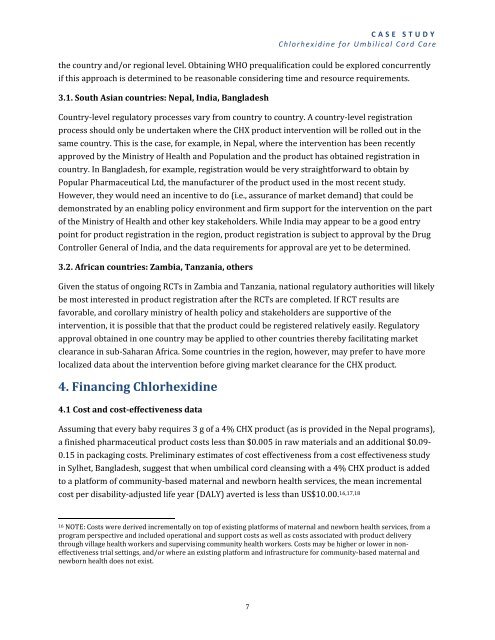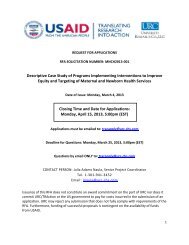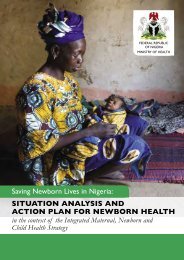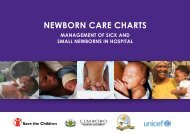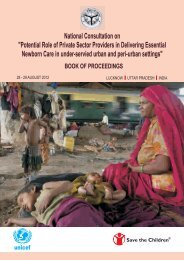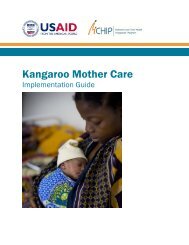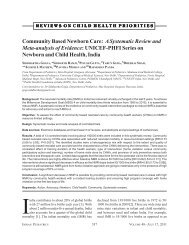Chlorhexidine for Umbilical Cord Care - Healthy Newborn Network
Chlorhexidine for Umbilical Cord Care - Healthy Newborn Network
Chlorhexidine for Umbilical Cord Care - Healthy Newborn Network
- No tags were found...
Create successful ePaper yourself
Turn your PDF publications into a flip-book with our unique Google optimized e-Paper software.
CASE STUDY<strong>Chlorhexidine</strong> <strong>for</strong> <strong>Umbilical</strong> <strong>Cord</strong> <strong>Care</strong>the country and/or regional level. Obtaining WHO prequalification could be explored concurrentlyif this approach is determined to be reasonable considering time and resource requirements.3.1. South Asian countries: Nepal, India, BangladeshCountry‐level regulatory processes vary from country to country. A country‐level registrationprocess should only be undertaken where the CHX product intervention will be rolled out in thesame country. This is the case, <strong>for</strong> example, in Nepal, where the intervention has been recentlyapproved by the Ministry of Health and Population and the product has obtained registration incountry. In Bangladesh, <strong>for</strong> example, registration would be very straight<strong>for</strong>ward to obtain byPopular Pharmaceutical Ltd, the manufacturer of the product used in the most recent study.However, they would need an incentive to do (i.e., assurance of market demand) that could bedemonstrated by an enabling policy environment and firm support <strong>for</strong> the intervention on the partof the Ministry of Health and other key stakeholders. While India may appear to be a good entrypoint <strong>for</strong> product registration in the region, product registration is subject to approval by the DrugController General of India, and the data requirements <strong>for</strong> approval are yet to be determined.3.2. African countries: Zambia, Tanzania, othersGiven the status of ongoing RCTs in Zambia and Tanzania, national regulatory authorities will likelybe most interested in product registration after the RCTs are completed. If RCT results arefavorable, and corollary ministry of health policy and stakeholders are supportive of theintervention, it is possible that that the product could be registered relatively easily. Regulatoryapproval obtained in one country may be applied to other countries thereby facilitating marketclearance in sub‐Saharan Africa. Some countries in the region, however, may prefer to have morelocalized data about the intervention be<strong>for</strong>e giving market clearance <strong>for</strong> the CHX product.4. Financing <strong>Chlorhexidine</strong>4.1 Cost and cost‐effectiveness dataAssuming that every baby requires 3 g of a 4% CHX product (as is provided in the Nepal programs),a finished pharmaceutical product costs less than $0.005 in raw materials and an additional $0.09‐0.15 in packaging costs. Preliminary estimates of cost effectiveness from a cost effectiveness studyin Sylhet, Bangladesh, suggest that when umbilical cord cleansing with a 4% CHX product is addedto a plat<strong>for</strong>m of community‐based maternal and newborn health services, the mean incrementalcost per disability‐adjusted life year (DALY) averted is less than US$10.00. 16,17,1816 NOTE: Costs were derived incrementally on top of existing plat<strong>for</strong>ms of maternal and newborn health services, from aprogram perspective and included operational and support costs as well as costs associated with product deliverythrough village health workers and supervising community health workers. Costs may be higher or lower in noneffectivenesstrial settings, and/or where an existing plat<strong>for</strong>m and infrastructure <strong>for</strong> community‐based maternal andnewborn health does not exist.7


